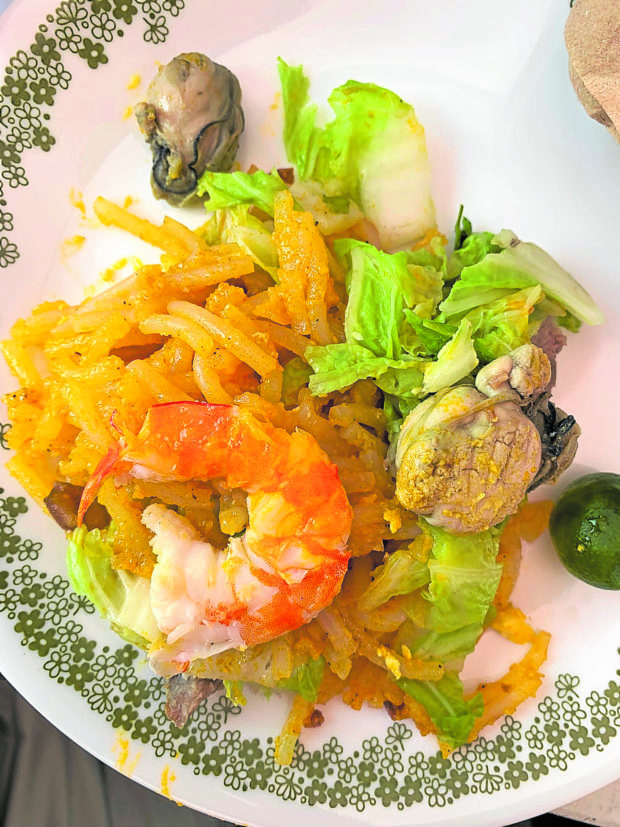Malabon’s title, the City of Taste and Heritage, couldn’t be any more appropriate and fitting, as it is home to some of the tastiest and most crave-worthy Filipino dishes I’ve ever had, especially since they’ve been seasoned with stories as juicy and flavorful as the food itself.
Nostalgic noodles
If there’s anything Malabon is known for, aside from kakanin and fish sauce, it’s their pancit. More than a handful of locals sell versions of this beloved noodle dish, but back in the day, there was one name that many locals relied on: Aling Rosy.
Cooking and serving pancit actually didn’t start from his grandmother Rosy, admits Carlo Agustin. The entrepreneurial 24-year-old is the fourth generation in the family to continue this tradition. Even before Aling Rosy began in the 1940s, her mom had set up a shop called Rosconbeldemer, a combination of the first names of all her daughters, selling a range of home-cooked food.

When Aling Rosy died in 2011, the family decided to shut down the business. But with cooking running in his veins, Carlo opened Mama Belen’s Kitchenette on the same spot where Aling Rosy’s stood. He carries practically the same food, with their pancit Malabon still being the most popular. He even uses the very same cooking utensils and processes his lola had, and hired the same cooks to operate his business.
Mama Belen’s remains among the most well-loved in the city because it is loyal to the original version, says Egay dela Fuente Ramos of the Malabon Tourism Office. Since the city is marked by rivers, it was customary back in the day to have seafood in their pancit, like cooked shrimps and fresh oysters. Mama Belen’s has those two in its version, along with hard-boiled eggs, Baguio pechay and boiled ox tongue. Oysters are available only upon request, though, and to avoid fast spoilage, Carlo cooks them adobo-style.
Streetside savories
When it comes to carinderia cravings, nothing satisfies quite as much as 83-year-old Milagros Tuazon’s fare. Opened in 1965, Aling Mely’s started out small, selling just a handful of viands from a corner of their house. She convinced her mother, who was working as a cook, to try her luck and see where their food would take them. Well, with consistently good dishes, the kind that makes customers come back daily and has people from far-flung areas of the metro reserving big orders, the humble shack has not just increased in space (the whole ground floor now makes up the kitchen and dining areas), but has also lasted more than 50 years.
Aling Mely’s sister Precy now runs the show, with Mely’s four kids having their own responsibilities in operations.
You can’t go wrong with whatever dish you pick. Just make sure to include the bestselling mechado in your order. They make at least 10 kg of it every day. It takes a long time to prepare, and you can see and taste it in both the rich and bold tomato sauce, as well as the very fork-tender meat.
My other favorites include the creamless lengua with hard-boiled quail eggs, and the fist-sized albondigas in misua and patola soup.
Not your traditional ‘turon’
There is turon, the log-shaped banana spring roll, and then there is Malabon’s Triangulo Valencia, which Tessie Punzalan, 76, continues to fry and sell outside her home in Barangay Flores, as she has for more than 30 years now.
The triangle-shaped snack is something she first tried in the public market back in 1950s. She liked it so much that she asked the guy selling it to teach her how it’s made. Weeks later, the vendor died.
To continue his legacy, Aling Tessie decided to sell it. She’s the only one doing so. She starts by tightly folding the saba banana and biko made of pinipig and ripe jackfruit into a piece of wrapper, then proceeds to fry it in oil with melted brown sugar. These days, she makes 200-300 pieces a day and runs out by early afternoon. She also has botching malagkit, a caramel-encased ball filled with mashed mung beans. INQSpecial thanks to Jaison Yang and Egay dela Fuente Ramos. Follow the author at @fooddudeph on Instagram.